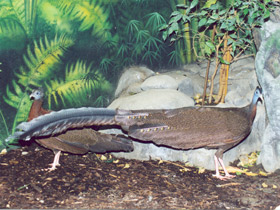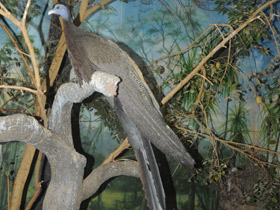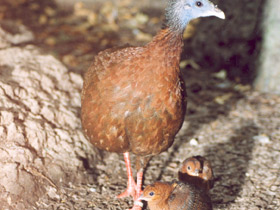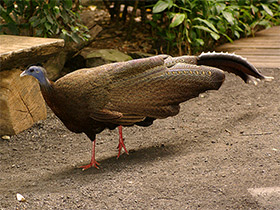The great argus Argusianus argus
The great argus is a large representative of the family Phasianidae, found in the South-East Asia and Indonesia. It has the sizes similar to those of the peafowl; body length of the male is 1.7–2 meters (with rectrices measuring up to 1.4 m), and the weight is 2.5–3 kg. The great argus was named by Carolus Linnaeus for the many eyes-like pattern on its wings. (In Greek mythology, Argus is a hundred-eyed giant.) Long secondary wing feathers of the great argus are decorated with complex pattern of eye-spots (ocelli), similar to the pattern on the train feathers of the peacock. Another impressive feature of the great argus is its amazing tail feathers that may reach almost 1.5 meters in length. Adult male finds an arena for courtship display within his home territory. The arena has a size of 4 to 5 m in diameter. The male clears a raised site in the centre of the arena from fallen leaves, twigs, and small stones. When hearing the sounds produced by approaching female, the male starts displaying, never leaving his arena during the courtship display. The male dances in front of the female with his wings spread into two enormous fans and the train raised. The male looks as though his head and body are sheltered by a huge, spectacular fan. (However, it is not easy to see the great argus in the wild; these birds live in dense shrub thickets of hardly accessible tropical forests.) Females actively choose to mate with the males that have more decorative wing and train colour patterns. The great argus is thought to be polygamous in the wild, and one male may mate with several females. After mating, the females leave the male’s home territory. They build nests in secluded places in tropical forests; like in other members of the pheasant family, their nests are presented by a simple scrape on the forest floor, lined with some nesting material. The clutches are unusually small for pheasants, containing no more than two eggs. The female starts incubating after she lays the last egg in the clutch. Incubation period lasts about 25 days. Hatchlings leave the nest as soon as they get dry and follow their mother everywhere. Their brownish down feathers help them blending in with the surroundings and make them inconspicuous. When threatened, the chicks run to their mother and hide under her wings. At the first stages of brood-rearing period, the mother feeds them bill-to-bill, but the chicks grow quickly and become independent by the age of several weeks. Great argus young reach sexual maturity by the age of one year. Great argus feed on various plants, as well as insects and other invertebrates.



















































